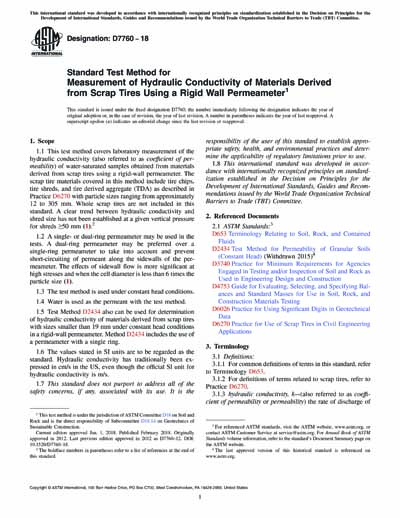Most recent
ASTM D7760-18
Standard Test Method for Measurement of Hydraulic Conductivity of Materials Derived from Scrap Tires Using a Rigid Wall Permeameter
1.1 This test method covers laboratory measurement of the hydraulic conductivity (also referred to as coefficient of permeability) of water-saturated samples obtained from materials derived from scrap tires using a rigid-wall permeameter. The scrap tire materials covered in this method include tire chips, tire shreds, and tire derived aggregate (TDA) as described in Practice D6270 with particle sizes ranging from approximately 12 to 305 mm. Whole scrap tires are not included in this standard. A clear trend between hydraulic conductivity and shred size has not been established at a given vertical pressure for shreds ≥50 mm (1).2
1.2 A single- or dual-ring permeameter may be used in the tests. A dual-ring permeameter may be preferred over a single-ring permeameter to take into account and prevent short-circuiting of permeant along the sidewalls of the permeameter. The effects of sidewall flow is more significant at high stresses and when the cell diameter is less than 6 times the particle size (1).
1.3 The test method is used under constant head conditions.
1.4 Water is used as the permeant with the test method.
1.5 Test Method D2434 also can be used for determination of hydraulic conductivity of materials derived from scrap tires with sizes smaller than 19 mm under constant head conditions in a rigid-wall permeameter. Method D2434 includes the use of a permeameter with a single ring.
1.6 The values stated in SI units are to be regarded as the standard. Hydraulic conductivity has traditionally been expressed in cm/s in the US, even though the official SI unit for hydraulic conductivity is m/s.
1.7 This standard does not purport to address all of the safety concerns, if any, associated with its use. It is the responsibility of the user of this standard to establish appropriate safety, health, and environmental practices and determine the applicability of regulatory limitations prior to use.
1.8 This international standard was developed in accordance with internationally recognized principles on standardization established in the Decision on Principles for the Development of International Standards, Guides and Recommendations issued by the World Trade Organization Technical Barriers to Trade (TBT) Committee.
Content Provider
ASTM International [astm]






